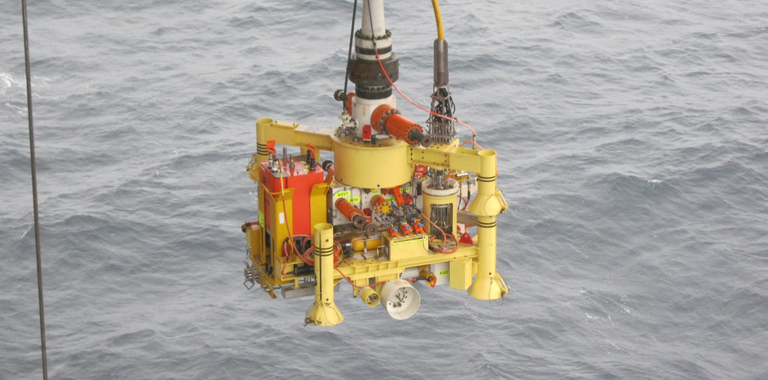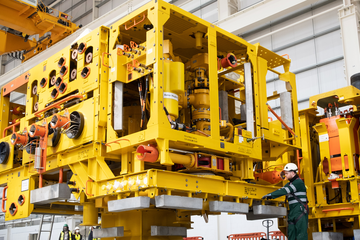Oveview
Subsea Tree Systems
Subsea trees are required to control hydrocarbon production and comprise assemblies of valves and other components installed at the wellhead to monitor, manage injection and control production flow from the reservoir. Tree orientations can be either vertical, with production tubing suspended in the wellhead, or horizontal, with production tubing suspended in the tree with features and materials suited to the operating conditions and the physical environment of each well.
Standardized and modular designs for consistency and speed
At the forefront of energy development, Baker Hughes have supplied more than 1,600 subsea trees globally since our first installation in 1962. Our trees are based on standardized, modular designs that drive high manufacturing efficiency and delivery speed helping minimize the time to first oil or gas, while maximizing the returns on customer developments.
Baker Hughes provides both 5-inch and 7-inch systems with up-to 15,000psi pressure rating capability—in a comprehensive range that facilitates control of intelligent completions in water depths up to 10,000 ft to maximize reservoir recovery.
Features and benefits of our subsea trees include:
- Modular design to suit development configurability with reduced lead times.
- Designed for ease of installation.
- Reduced CO2 footprint.
- High reliability and pedigree in core valve, sealing and connector technologies
Aptara Suite of Tree systems
The Aptara suite of Tree systems has expanded since its launch, providing greater choice and flexibility in design for our customers development needs whilst being built on the proven technology and decades of experience of Baker Hughes subsea products. Built around a 10,000psi (690Bar), 10,000ft (3,048m), 300°F (149°C) framework and leveraging product sharing philosophies, the Aptara suite now includes
Aptara-C (AXTC), a lightweight compact tree, designed to reduce initial CAPEX as well as OPEX over the entire life of your field.
Aptara-L (AXTL) provides a concentric bore vertical tree system simplifying installation or intervention and paired with an Integrated Process Module®.
Aptara-H Horizontal Tree (AHXT) leverages Baker Hughes market leading technology in large bore trees, providing a lightweight solution with strong features and functions.
Deepwater Horizontal Tree
This DHXT tree system’s highly flexible design and capability improves both reservoir management and hydrocarbon recovery in an efficient package that is available to deliver the systems in short cycle durations. Configurability includes choices of Flow Control modules, or individual retrievable items where life-of-field interventions may be less frequent ensures a wide coverage to suit each development.
Medium Water Horizontal Tree
With pre-configured CAPEX efficient arrangements, the MHXT can offer the potential to reduce OPEX installation costs with capability of use from lower cost jack-up rigs while eliminating the need for an open water completion riser and providing simplicity in tooling for OPEX. The MHXT is the rapid delivery solution for medium water small pool hydrocarbon recovery, brownfield extensions, improving project economics with a fast investment return.
Shallow Water Tree Systems
Baker Hughes have over 30 years’ experience in Shallow Water environments using Tree and Wellhead systems and enabling the use of low cost Jack Up Drilling Rigs. Providing innovative light weight Tree systems paired with flexible functionality, the Shallow Water Horizontal and Vertical Tree solutions provide a low-cost solution to operators where environmental challenges exist and efficiencies can be achieved.
High Pressure High Temperature (HPHT)
Baker Hughes have over 20 years of Subsea HPHT field experience and provide solutions with integrity at their heart utilizing proven designs, product developments, and the latest technology in materials. Enabled to cater to the production pressures of up to 15,000psi, flowing temperatures of up to 350°F and matched with pre-engineered configurable solutions to suit such extremes, the HPHT Tree system addresses the individual needs of the development, enables short cycle delivery, and aligns to available installation and intervention packages.
Flow Management
With multiple choices on individual development needs, Baker Hughes can provide the optimum solution for each project development, including Choke Inserts, Flow Control Modules, and the latest innovation of the Integrated Process Module (IPM) with combined multiple features.
Developed through a collaboration between Emerson's Roxar™ Wet Gas Flow Meter Technology and Baker Hughes Electric Choke, the IPM brings a new level of efficiency and convenience, combining multiple features and functions into a single smaller retrievable unit and enabling greater flexibility for installation, safety, and reliability.


